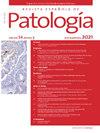心脏淀粉样变:根据眼科发现和怀疑作出的诊断
IF 0.5
Q4 Medicine
引用次数: 0
摘要
背景淀粉样变性是指以淀粉样蛋白细胞外沉积为特征的一组不同类型的疾病。淀粉样蛋白主要积聚在周围神经、心脏和眼睛中。由于淀粉样蛋白在玻璃体腔内积聚,眼部表现之一是浮游物和视力逐渐下降。在眼底检查中发现了致密的玻璃体混浊,因此进行了治疗性玻璃体旁切除术。样本被送去进行病理分析,怀疑是眼淀粉样变性。组织病理学检查发现,无定形的细胞物质在刚果红染色下呈现苹果绿双折射。免疫组化染色和基因检测发现了一种与家族性淀粉样变性多发性神经病相关的变异体。随后,对患者进行了全面的系统评估,包括超声心动图和磁共振成像,结果显示患者存在轻度室间隔肥厚和舒张功能障碍。本病例强调了眼科临床怀疑的重要性及其在促进系统评估以获得正确诊断和尽早开始适当治疗方面的作用。本文章由计算机程序翻译,如有差异,请以英文原文为准。
Cardiac amyloidosis: A diagnosis made from an ophthalmological finding and suspicion
Background
Amyloidosis refers to a heterogeneous group of diseases characterized by extracellular deposits of amyloid. Transthyretin is one of the precursor proteins in hereditary forms, where amyloid mainly accumulates in peripheral nerves, the heart and the eye. One of the ocular manifestations is floaters and a progressive decrease in visual acuity, due to its accumulation in the vitreous humour.
Clinical case
A 70-year-old man consulted due to a bilateral decrease in visual acuity. Dense vitreous opacities were observed during the ocular fundus exam, so a therapeutic pars plana vitrectomy was performed. The samples were sent for pathology analysis with a suspicion of ocular amyloidosis. The histopathological examination revealed amorphous cellular material showing apple-green birefringence with Congo red staining. Immunohistochemical staining and genetic testing identified a variant associated with familial amyloidotic polyneuropathy. Subsequently, a comprehensive systemic evaluation was performed, including an echocardiogram and magnetic resonance imaging, which revealed mild septal hypertrophy and diastolic dysfunction.
Conclusions
We present a case of cardiac involvement caused by hereditary amyloidosis, diagnosed through vitreous biopsy. This case highlights the importance of ophthalmological clinical suspicion and its role in facilitating a systemic evaluation leading to the right diagnosis and the early initiation of the appropriate therapy.
求助全文
通过发布文献求助,成功后即可免费获取论文全文。
去求助
来源期刊

Revista Espanola de Patologia
Medicine-Pathology and Forensic Medicine
CiteScore
0.90
自引率
0.00%
发文量
53
审稿时长
34 days
 求助内容:
求助内容: 应助结果提醒方式:
应助结果提醒方式:


